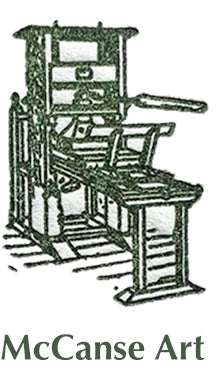Stanley Francis Turner
Stanley Francis Turner (1883-1953), RCA, OSA, CSPEE, was a Canadian artist and cartographer. While Turner worked in various art mediums, he is lauded for his intaglio and woodcut prints and is perhaps best recognized today for his etchings of Toronto and Quebec street scenes, which demonstrated his particular eye for capturing everyday bustle amid the cities’ quintessential architecture.

Turner was born in Aylesbury, England in 1883 and studied at the South Kensington School of Art in London. After turning 18 in 1901, he immigrated to Yorkton, Saskatchewan and took up farming. He continued his sketching until he moved to Toronto in 1911, where he joined the advertising department of T. Eaton Company. He also found work at the Grip, a Toronto-based design firm founded in 1873 by noted caricaturist and cartoonist J.W. Bengough. Working alongside Turner at the Grip were a number of the artists that would come to form the Group of Seven. It was here at the Grip where they met one another for the first time: these members included J.E.H. Macdonald, who served as the firm’s head designer in 1906, later hiring Frank Johnston and Tom Thomson in 1908 and 1909 respectively. In 1911 Franklin Carmichael was hired as an office boy in the same year that Arthur Lismer emigrated from England and joined the firm as well. Frederick Varley, following Lismer’s advice, found work at the Grip in 1912.
Turner began to see some recognition for this art; he won first prize for the Eaton Jubilee Cover competition in 1913, and in 1918 he joined the reputable design and advertising firm of Rous and Mann Press Ltd., where he worked under Franklin Carmichael. He received an Eaton scholarship to attend the Ontario College of Art in Toronto and studied there with George Reid and J.W. Beatty. By 1930 Turner was elected an Associate of the Royal Canadian Academy of Arts (RCA).

Writing on Turner’s work, Patricia Ainslie in Images of the Land: Canadian Block Prints 1919-1945 describes the influence that 19th century English illustration, in particular those associated with narrative, had on Turner’s colour woodcuts. Turner also took inspiration from the Japanese style of printmaking.
In Queen Street, Toronto (left), one can see Turner’s twin focus on capturing architectural detail alongside the activity of human life in the city; here, Turner draws our attention to the prevalent and recognizable monument of (what is now) old City Hall (?) with some of the skyline visible around it, but he does not compromise on the more minute “street-level” details, including the storefront signs (one of which is written in Japanese and, because of the perspective and comparative size, competes for our attention with the clock tower right beside it), the faces of passers-by, and other seemingly insignificant details as commonplace as the nails in the telephone pole. Turner captures both the immediate life we see on the street—the people moving in the foreground and the ice skater, who also competes for our eye as with the clock tower, both of which are isolated by a comparative lack of surrounding detail—but also the suggestion of other activities, future or unseen; e.g., the sign advertising the Diamond Café and the more illicit suggestions of gambling and such that might occur later in the day, which is now just breaching 5 o’clock—the end of the working day.

Among Turner’s other works is the silkscreen Parliament Buildings, Ottawa, 1941(right), which he made two years into the second world war. Here one could see the influence of English illustration described by Ainslie; the warmer palette emphasizing the light dawning and reflecting brightly off the distant buildings—national symbols as the seat of government power in the country’s capital—gives the scene romance and grandiose, impressing the viewer with a notion of optimism at a time when national pride and hope was much-needed.
Turner’s work received numerous recognitions and critical acclaim. The Globe and Mail twice commissioned him to prepare illustrated war maps during the second world war. Turner became celebrated for his illustrations in Canadian historical novels including Thomas H. Raddall’s Tambour (1945) and Son of the Hawk (1950), producing similar drawings for magazines such as Maclean’s. Turner continued to exhibit his work from the 1920s through the 1930s.
Turner has been awarded various prizes, including winning the poster competition at the Canadian National Exhibition in Toronto on four occasions, first prize at the Eaton Jubilee Cover competition (Toronto, 1918), and bronze medal at the Royal Society of Arts and Commerce (London, 1898). Turner’s work is held within the public collections of the Art Gallery of Ontario, the Art Gallery of Hamilton, the Canadian War Museum in Ottawa, the Glenbow Museum in Calgary, Hart House in Toronto, the Los Angeles Couy Museum of Art, the McCord Museum of Canadian History in Montreal, the Montreal Museum of Fine Arts, National Gallery of Canada, New Brunswick Museum, Northwestern University, Royal Ontario Museum of Toronto, Toronto Reference Library, the University of Saskatchewan, and the Victoria and Albert Museum in London.
Rous and Mann Stanley Turner Catalogue Download
Written by Mina Ivosev.
Sources:
“Frederick Varley.” Wikipedia.
“Saskatchewan NAC Artists | Stanley Francis Turner.” Saskatchewan NAC Artists.
Ainslie, Patricia. Images of the Land: Canadian Block Prints 1919-1945. 2nd ed. Glenbow Museum, 1985, p. 51.
